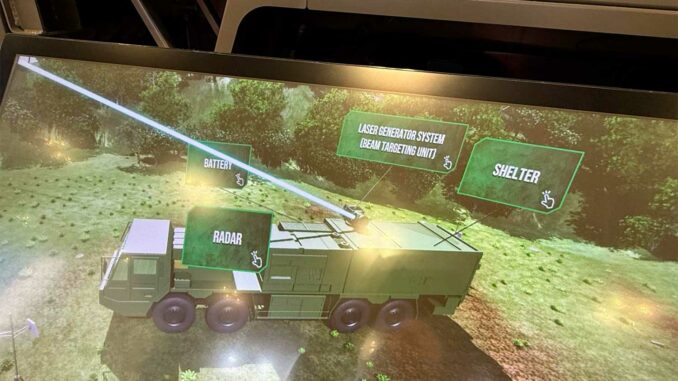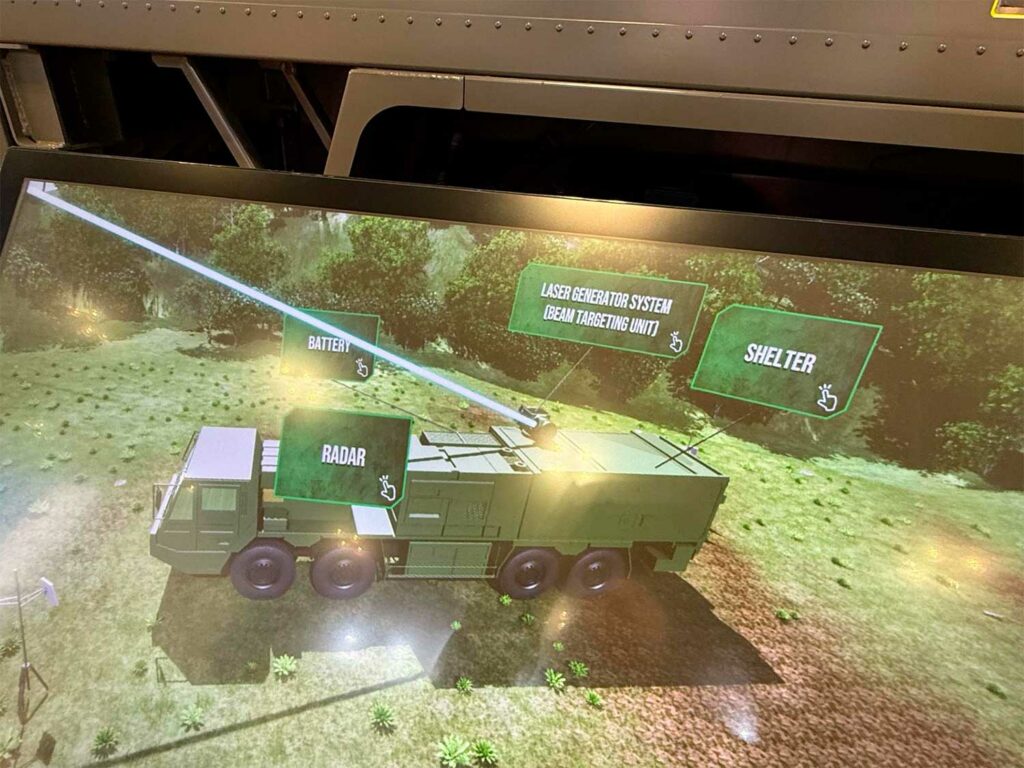
Japan has unveiled a 10 kW truck-mounted laser system designed to neutralize drones. This marks a step toward low-cost mobile defense.
At the DSEI Japan 2025 exhibition, the Japanese Ministry of Defense unveiled a vehicle-mounted laser cannon, currently under development by the Acquisition, Technology & Logistics Agency (ATLA). This 10-kilowatt system, installed on an 8×8 truck, is designed to neutralize short-range aerial targets, particularly drones. It stands out for its very low cost of engagement, high mobility, and potential to complement conventional multi-layered defenses. It is part of a strategy to modernize Japan’s anti-drone and close protection capabilities. The system is still in the field testing phase, with no specific timeline for operational deployment.
Combat laser unveiled to the Japanese public for the first time
Japan has unveiled a vehicle-mounted high-energy laser system for the first time at DSEI Japan 2025. The prototype, developed by the state-run Acquisition, Technology & Logistics Agency (ATLA) in coordination with the Japanese Ministry of Defense, marks a step toward the integration of directed energy systems into the Japanese armed forces.
The laser cannon, officially designated the Vehicle-Mounted High-Power Laser System, is integrated onto an 8×8 military truck chassis. It is a demonstration prototype equipped with a 10-kilowatt laser capable of destroying or disrupting low-altitude aerial targets such as light drones.
This type of system aims to respond to a growing threat: the proliferation of low-cost drones, sometimes used in swarms, which conventional munitions struggle to counter in an economically viable manner. The JGSDF (Japan Ground Self-Defense Force) plans to combine this system with other defense measures to establish multi-layered protection against short-range air threats.
A system designed for mobility and low engagement costs
One of the key arguments put forward by program officials is the extremely low unit cost per shot. Unlike conventional surface-to-air missiles or cannon systems, which require expensive ammunition, the laser cannon only needs electrical power to operate. This allows for a significant reduction in operational costs, which is particularly advantageous in a confrontation with multiple or continuous drones.
For example, the cost of firing an anti-aircraft missile such as the PAC-3 is estimated at $3 million per unit, while a laser shot, according to US estimates, costs just a few dollars, depending on the power and duration of operation. In the context of saturation or swarm attacks, this difference becomes strategic.
The 8×8 chassis also offers rapid projection capability over varied terrain, with a good level of operational mobility. The system can thus be redeployed as needed, enhancing its tactical effectiveness in complex environments such as the islands of southwestern Japan or densely populated urban areas.

A response to low-altitude, slow, and small drones
The laser cannon is designed to counter LSS (low, slow, small) targets: commercial drones, modified quadcopters, or homemade devices used for reconnaissance or harassment. These devices are difficult to intercept with conventional systems because they evade traditional radar or guided missiles due to their low thermal signature and irregular mobility.
Faced with this reality, Japan has been strengthening its counter-UAS (Counter Unmanned Aerial Systems) programs since 2022, incorporating non-kinetic technologies such as radio frequency jammers, microwave cannons, and now lasers. The ATLA laser system fits into this framework as a clean neutralization tool that generates no ballistic debris or massive collateral damage, which is essential in civilian contexts or near critical infrastructure.
It also reduces the response time, as the laser fires immediately upon detection of the target. This makes it a suitable tool for protecting sensitive sites such as military bases, nuclear facilities, and ports.
A program still in the experimental phase but with strong potential
Although it has been publicly unveiled, the system remains at the technology demonstration stage. No production orders have yet been announced, and field trials are continuing. The Japanese Ministry of Defense has stated that deployment decisions will depend on the results of these tests, particularly in terms of robustness, reliability, and compatibility with existing defense networks.
Real-world testing will focus on:
- targeting accuracy in a jammed environment,
- multiple firing capabilities without loss of power,
- resilience to harsh weather conditions (fog, rain, humidity),
- and the energy consumption of the system in operational situations.
Comparable projects have already been carried out by the United States with the HEL-MD (High Energy Laser Mobile Demonstrator) program, and by Germany with the Laser Weapon Demonstrator (LWD). Japan seems to be drawing inspiration from these approaches while adapting its systems to the specific constraints of its territory.
Towards standardization of directed energy weapons?
The Japanese laser project is part of a global trend towards non-kinetic defense systems, driven by falling production costs for high-power industrial lasers and the miniaturization of optical components.
In 2024, according to a report by Research and Markets, the global market for directed energy weapons was worth around $6.5 billion, with annual growth forecast at 18% until 2030. The main players are the United States, China, Israel, Russia, and now Japan.
The development of an operational vehicle-mounted laser could also have industrial spin-offs. The local integration of detection, optics, and power technologies could strengthen the production capabilities of advanced components in the Japanese defense industry, which is still dominated by a few large groups such as Mitsubishi Heavy Industries and NEC.
War Wings Daily is an independant magazine.